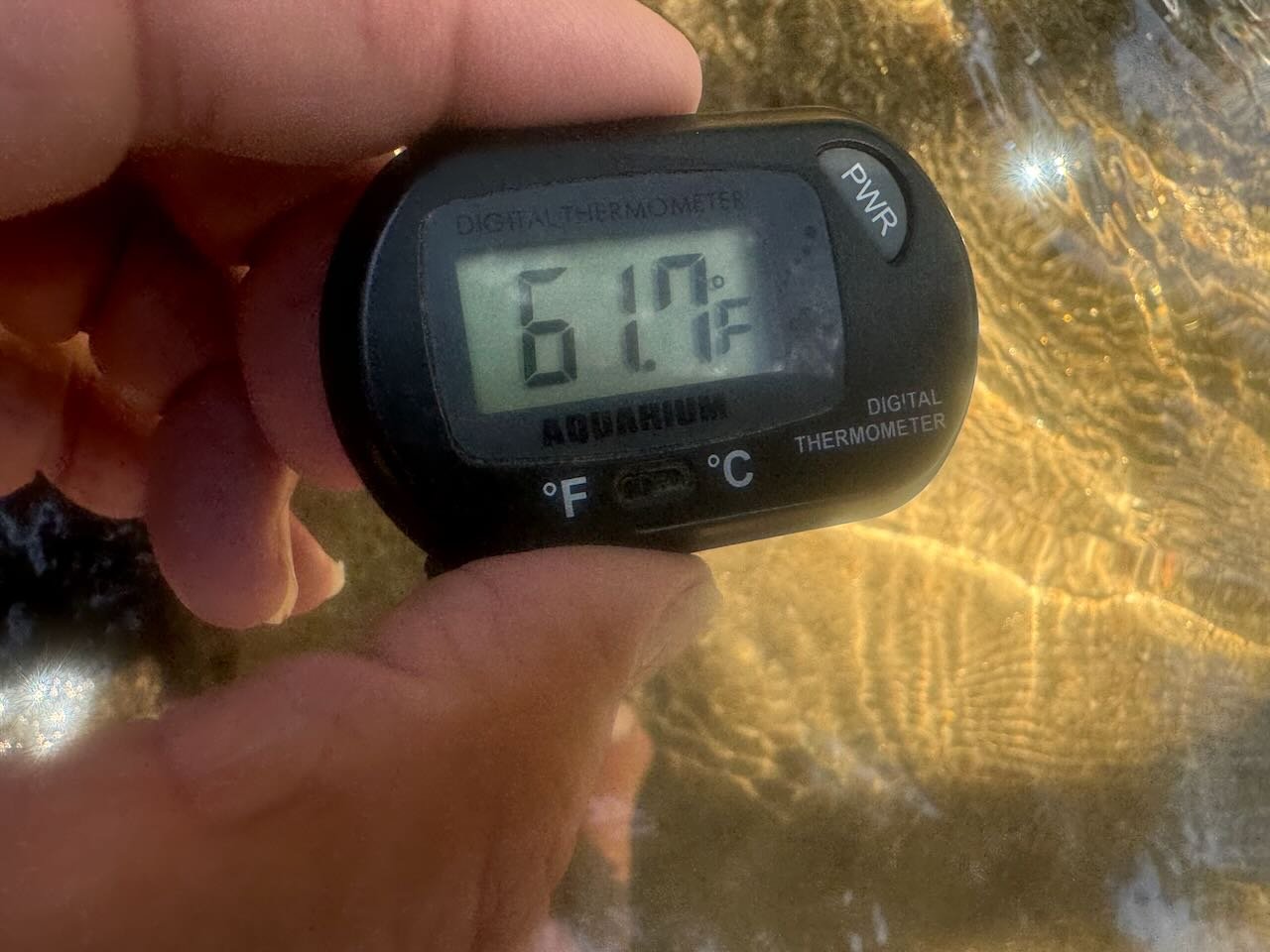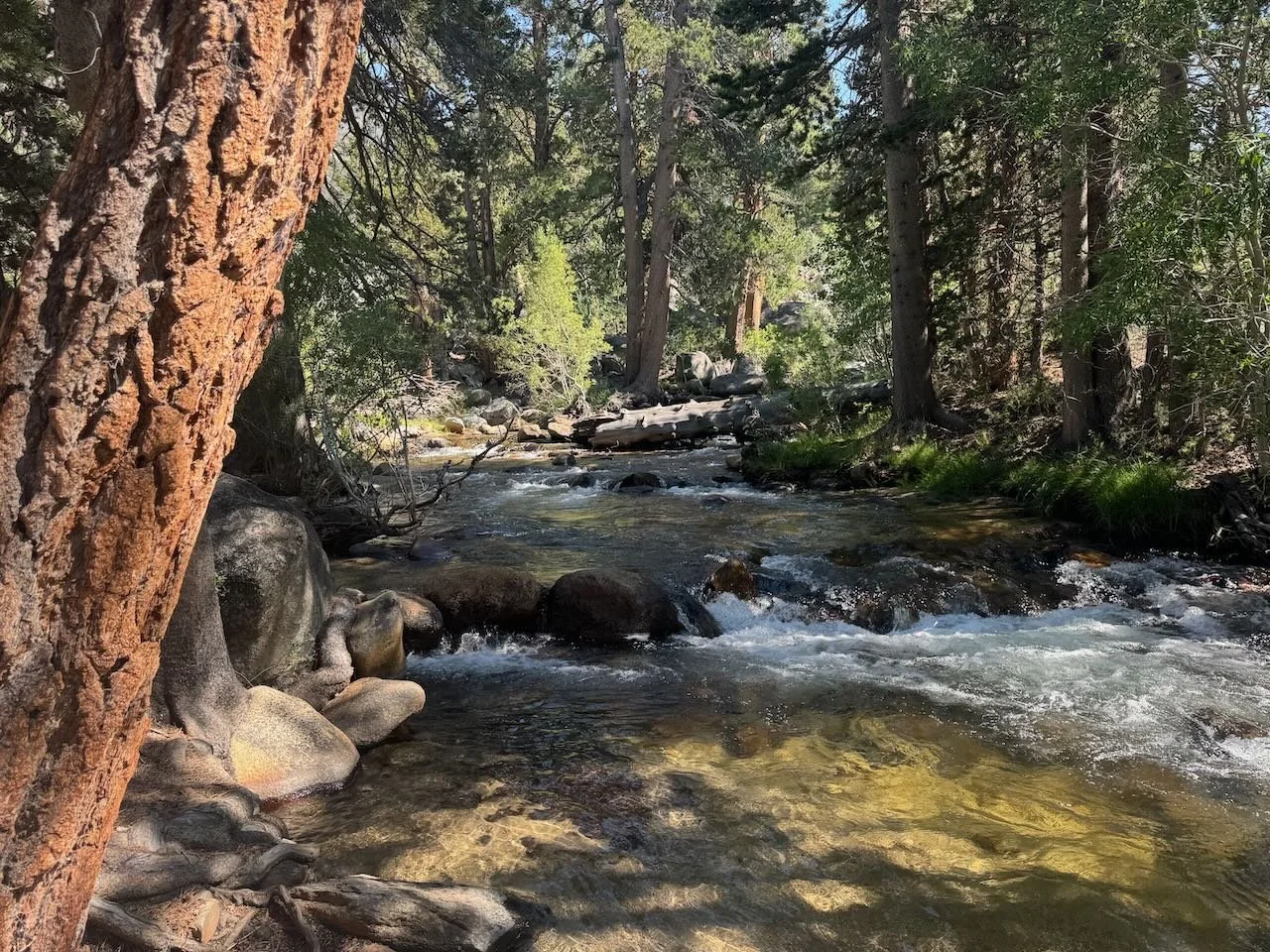Summer heat continues to pound the Eastern Sierra. Fly fishers should be implementing a voluntary hoot owl restrictions on Eastern Sierra waters that are having temperatures in the upper 60’s or higher. Most Eastern Sierra moving waters are fine, but the East Walker River is definitely a water that needs to be fished early and late in the day as day time water temperatures are in the high 60’s and low 70’s. Dry fly fishing has been productive on several waters in the Eastern Sierra. Grasshoppers are maturing into adults and now that they have wings they can be blown onto the streams in the afternoon winds. This is probably the only time as a fly fisher I hope for afternoon winds. Hatches of mayflies, caddis and midges are fueling the daily feeding habits of trout.
During the summer months fly fishers need to check the water temperatures of the waters they fish so they can stop fly fishing when water temperatures reach 70 degrees or higher..
East Walker River
Miracle Mile Section:
The waters in Bridgeport Reservoir are shallow and easily warm up in the summer time. These are the waters that flow through the East Walker River below the reservoir. This is a water that should be fished early in the morning as water temperatures are in the low 70’s by mid-day. For fly fishers getting on the water early fish with size 16 olive caddis emergers, size 16 olive La Fontaine sparkle emergers, size 12 stoner nymphs and size 12 golden stone nymphs to catch rainbows and browns to 16 inches. Fly fishers need to be off the water no latter then noon.
Zack Burns from Los Angeles fly fishing the East Walker River in the morning before the water temperatures get above 70 degrees.
Hot Creek
Interpretive Site:
Summer time is dry fly fishing time on Hot Creek. The interpretive site is one of the best places to dry fly fish. Consistent hatches of mayflies and caddis have trout feeding on the surface from early morning to early afternoon. The action starts in the morning with trico mayflies hatching. It starts with the nymphs hatching into the duns. The tricos quickly go from the dun stage to the sexually mature spinner stage. This hatch ends with the trico spinner fall. For the dun stage fish with a size 22 female dun parachute, or male dun parachute. When the spinner fall starts switch to a size 22 trico spinner pattern. When the spinner fall is just about over the blue wing olive may fly hatch starts. When the trout quit feeding on your trico spinner pattern switch to a size 20 blue wing olive parachute or olive sparkle dun. When the trout quit sipping mayflies off the water and start jumping out of the water in a showy, splashy rise form it’s time to switch to a size 20 gray elk hair caddis or gray caddis parachute. To be successful fly fishers need to know which stage of which insect the trout is feeding on and be able to make a drag free drift.
This time of year is when the weed beds in Hot Creek make fly fishing the canyon section tough with little room to float flies between the tiny lanes created in between the weed beds.
Hot Creek
Canyon Section:
The canyon section of Hot Creek requires fly fishers to make pin point accurate casts and drifts to fool the wary trout that are hanging out under the mats of weed beds that are always present at this time of the year. The right fly pattern on a drag free drift will produce trout in these tough conditions. I start the morning using a size 22 trico spinner pattern. If the trout are refusing my spinner pattern I switch to a size 22 trico female dun parachute pattern. As the trico hatch subsides the blue wing olive hatch begins. For this hatch I like to use a size 20 olive sparkle dun or blue wing olive parachute. As the blue wing olive hatch subsides the gray caddis hatch begins. For this hatch I like to fish a size 20 gray elk hair caddis, gray parachute caddis or gray CDC caddis. For the fly fishers that find these tiny dry flies hard to see on the water try fishing with a size 16 Adams parachute with a three foot tippet tied to the hook bend to attach the tiny dry flies to. This aids in seeing the flies on the water as well as the Adams acting like an indicator.
Brown trout are one of the species that fly fishers are looking to catch in Crowley Lake.
Crowley Lake
Mouth of McGee:
Working the weed beds from shore or with a float tube is a great way to present damsel fly nymphs, callibaetis nymphs and perch fry to trophy trout cruising the weed beds looking for a meal. The trout are feeding on the perch fry as they are big enough to offer the trout a big meal. Size 10 balanced perch, silver bodied matukas and olive wooly buggers are just few of the perch fry imitations that will fool trout. Best way to fish around the weed beds is with a sink tip line or a full sink line. Use different retrieves with the different insect and perch fry imitations. The flotilla of boats continues to work the flats around the inlet of McGee Creek. Working midges in 10 to 15 feet of water is producing trout until the wind comes up late morning or early afternoon. Suspend your midges from three inches to four feet above the substrate depending on where in the water column the concentration of midge pupae are that the trout are feeding on. Use size 18 tiger midge, zebra midge, blood midge, albino Barron and a gray midge under an indicator.
Introduction to Fly Fishing client Jeremy Pipp from San Clemente hooked up to a rainbow trout on the Upper Owens River.
Upper Owens River
Above Benton Crossing Bridge:
A major hopper hatch is not going to happen this year. As the hoppers become adults and start flying as fly fishers work the banks of the river a few hoppers will find their way into the river. Use size 12 tan bodied parachute hoppers, tan bodied stimulators and tan bodied Dave’s hoppers in the afternoon winds. Cast the flies into the wind against the bank the wind is blowing from. Nymphing with size 16 bead head flash back gold ribbed hare’s ears, size 18 bead head flash back pheasant tail nymphs, size 20 tiger midges and zebra midges are producing wild rainbow and brown trout to 14 inches. Trout are taking Adams parachutes in size 16 and 18, elk hair caddis in size 16, and blue wing olive parachutes in size 18 on the surface. Pulling streamers in size 6 or 10 like black wooly buggers, black matukas and black and white marabou muddlers are producing hard hits from 10 to 18 inch trout.
Fly fishing the soft edges next to the fast water sections of Rock Creek is producing wild brown trout up to 12 inches with a dry and dropper rig.
Rock Creek:
As a freestone creek Rock Creek flows have started to subside. Fishing with a size 16 Adams parachute and a size 16 bead head flash back gold ribbed hare’s ear tied onto a three foot tippet of 5X fluorocarbon to the bend of the Adams parachute is producing wild brown trout. Successful fly fishers will cover lots of water working the slower pools and runs where the trout are staying out of the faster currents to conserve energy. Fly fishers fishing with their favorite dry fly and nymph combo will fish them with more confidence and therefore catch more trout.
Hot temperatures make fly fishing tough in the middle of the day on Bishop Creek Canal.
Bishop Creek Canal
Behind Bishop Veterinary Hospital:
Day time temperatures have risen back up to the low 100’s making mid-day fly fishing uncomfortable for fly fishers. Afternoon rain showers could cool off the temperatures enough for mid-day fly fishing with nymphs and dries. There have been adult grass hoppers on the banks of the canal. A hopper dropper rig is producing wild brown trout for fly fishers willing to fish in the mid-day heat. For the hopper pattern try a size 12 stimulator, parachute hopper or a foam hopper. For the nymphs fish with a three foot tippet of 5X fluorocarbon tippet with size 16 bead head flash back gold ribbed hare’s ear, size 18 bead head flash back pheasant tail nymphs and size 14 green/gold wire Prince nymphs. With the heat during the day this is a water that fly fishers need to check water temperatures and stop fly fishing when the water temperatures reach 70 degree or higher.







